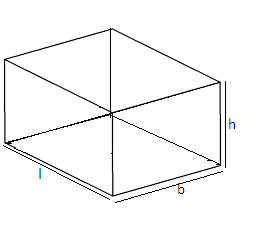
If l=$150$cm, b=$1$ m and h=$2$m then, the volume of the cuboid is-
A.$3,00,000$ cu.m.
B.$3,00,00,000$ cu.cm.
C.$30,00,000$ cu.cm.
D.$30,000$ cu.m.
Answer
567.6k+ views
Hint: Here length is in cm and breadth and height are in m so first we will convert the units meter into centimeter using $1m = 100cm$. Now use the formula of volume of cuboid which is given as-
$ \Rightarrow $ Volume of cuboid=$l \times b \times h$ where l is length of the cuboid, b is the breadth and h is height of the cuboid
Put the given values and multiply the numbers to get the answer.
Complete step-by-step answer:
Given, l=$150$cm, b=$1$ m and h=$2$m
Now we have to find the volume of the cuboid.

We are given some values in cm and some values in m so first, we will convert meter into centimeter.
We know that $1m = 100cm$
Then on using this we get,
$ \Rightarrow $ b=$1m = 100cm$
And h=$2m = 2 \times 100cm = 200cm$
Now we know that the formula of volume of cuboid is given as-
$ \Rightarrow $ Volume of cuboid=$l \times b \times h$ where l is length of the cuboid, b is the breadth and h is height of the cuboid
On putting the values, we get-
$ \Rightarrow $ Volume of cuboid=$150 \times 100 \times 200$
On multiplication we get-
$ \Rightarrow $ Volume of cuboid=$15000 \times 200$
On further multiplication, we get-
$ \Rightarrow $ Volume of cuboid=$30,00,000$$c{m^3}$
The correct answers are option C and option D.
Note: Here many students get the value wrong if they multiply all the numbers together. To avoid this problem, first multiply the first two numbers or you can multiply either of the two numbers. Then multiply the remaining number with the number obtained. It will make the calculation easy if we multiply the numbers one by one instead of multiplying them simultaneously.
If students want to convert the unit cm into m then, we know that$1m = 100cm$
From here we get-
$ \Rightarrow 1 cm = \dfrac{1}{{100}}m$
Then l=$150cm = \dfrac{{150}}{{100}}m = 1.5m$
Now on putting the values in the formula of volume of cuboid, we get-
$ \Rightarrow $ Volume of cuboid=$1.5 \times 1 \times 2$
On multiplication we get-
$ \Rightarrow $ Volume of cuboid=$3{m^3}$
None of the options match. Hence we convert m into cm.
$ \Rightarrow $ Volume of cuboid=$l \times b \times h$ where l is length of the cuboid, b is the breadth and h is height of the cuboid
Put the given values and multiply the numbers to get the answer.
Complete step-by-step answer:
Given, l=$150$cm, b=$1$ m and h=$2$m
Now we have to find the volume of the cuboid.

We are given some values in cm and some values in m so first, we will convert meter into centimeter.
We know that $1m = 100cm$
Then on using this we get,
$ \Rightarrow $ b=$1m = 100cm$
And h=$2m = 2 \times 100cm = 200cm$
Now we know that the formula of volume of cuboid is given as-
$ \Rightarrow $ Volume of cuboid=$l \times b \times h$ where l is length of the cuboid, b is the breadth and h is height of the cuboid
On putting the values, we get-
$ \Rightarrow $ Volume of cuboid=$150 \times 100 \times 200$
On multiplication we get-
$ \Rightarrow $ Volume of cuboid=$15000 \times 200$
On further multiplication, we get-
$ \Rightarrow $ Volume of cuboid=$30,00,000$$c{m^3}$
The correct answers are option C and option D.
Note: Here many students get the value wrong if they multiply all the numbers together. To avoid this problem, first multiply the first two numbers or you can multiply either of the two numbers. Then multiply the remaining number with the number obtained. It will make the calculation easy if we multiply the numbers one by one instead of multiplying them simultaneously.
If students want to convert the unit cm into m then, we know that$1m = 100cm$
From here we get-
$ \Rightarrow 1 cm = \dfrac{1}{{100}}m$
Then l=$150cm = \dfrac{{150}}{{100}}m = 1.5m$
Now on putting the values in the formula of volume of cuboid, we get-
$ \Rightarrow $ Volume of cuboid=$1.5 \times 1 \times 2$
On multiplication we get-
$ \Rightarrow $ Volume of cuboid=$3{m^3}$
None of the options match. Hence we convert m into cm.
Recently Updated Pages
Master Class 8 Maths: Engaging Questions & Answers for Success

Class 8 Question and Answer - Your Ultimate Solutions Guide

Master Class 12 Economics: Engaging Questions & Answers for Success

Master Class 12 Maths: Engaging Questions & Answers for Success

Master Class 12 Biology: Engaging Questions & Answers for Success

Master Class 12 Physics: Engaging Questions & Answers for Success

Trending doubts
What is BLO What is the full form of BLO class 8 social science CBSE

Which one of the following groups comprises states class 8 social science CBSE

Citizens of India can vote at the age of A 18 years class 8 social science CBSE

Full form of STD, ISD and PCO

A couple went for a picnic They have 5 sons and each class 8 maths CBSE

Right to vote is a AFundamental Right BFundamental class 8 social science CBSE





